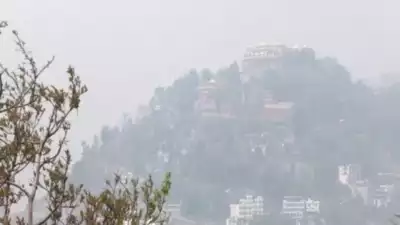
Kathmandu: A thick layer of haze enveloped the Kathmandu Valley, pushing the Air Quality Index (AQI) into the ‘Very Unhealthy’ category on Monday.
According to the Ministry of Forests and Environment’s Department of Environment Air Quality Monitoring, the air quality in Bhaisipati was classified as ‘Hazardous,’ with a US AQI reading of 333 as of 2:30 pm (local time).
On Monday afternoon, the dense, polluted haze disrupted flight operations at Tribhuvan International Airport (TIA), leading to the diversion of at least half a dozen international flights.
According to TIA spokesperson Rinji Sherpa, flights from Jazeera Airways, Air India, and Fly Dubai were unable to land due to poor visibility early in the morning.
“This morning, visibility was only 1,600 meters, which did not meet the required standards for landing,” said Sherpa. “Now, visibility has improved to 3,000 meters, but dust and haze continue to pose challenges.”
Two flights from Jazeera Airways and Air India were redirected to Varanasi, India, while a Fly Dubai flight was diverted to Gautam Buddha International Airport in Bhairahawa. Other flights faced short delays before landing.
Other flights faced short holds before landing.
Dipesh Darshandhari, a resident of Kathmandu, described the impact of the worsening pollution. “Pollution has increased tremendously. While overseeing the Kathmandu Valley from the top of Swayambhunath Stupa, it is all covered by a thick grey haze, dipping the visibility. I am also experiencing burns in my eyes, and my throat is also itchy,” Darshandhari told ANI.
According to the Air Quality Index, the PM2.5 concentration in Kathmandu Valley stood at 209.8 ug/m3. PM2.5 refers to particulate matter (solid or liquid droplets) in the air that is less than 2.5 micrometers in diameter.
These fine particles are among the most dangerous air pollutants as they can bypass the nose and throat, penetrate the lungs, and even enter the bloodstream. Due to their small size, PM2.5 particles remain suspended in the air for extended periods, increasing the risk of inhalation.
Kathmandu, a city known for its medieval palaces and temples, is the largest metropolitan area in Nepal. It serves as a hub for history, art, culture, education, healthcare, and the economy.
In recent years, air pollution in Nepal has become a major environmental and public health crisis, with pollution levels recorded at 4.9 times higher than the World Health Organization’s (WHO) recommended standards.
The deteriorating air quality in Kathmandu is placing hundreds of thousands of Nepalese at risk of severe health problems. The WHO has consistently identified air pollution as the leading risk factor for death and disability in Nepal.
The worsening air quality has become a significant public health concern, contributing to air pollution-related illnesses and deaths. It also places an economic burden on the country due to lost productivity and increased pressure on healthcare resources. Additionally, there is a lack of comprehensive health impact assessments to determine the full extent of air pollution’s health and economic consequences, as well as the sectoral measures required to combat this environmental challenge. (ANI)

